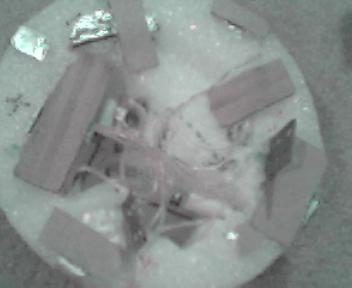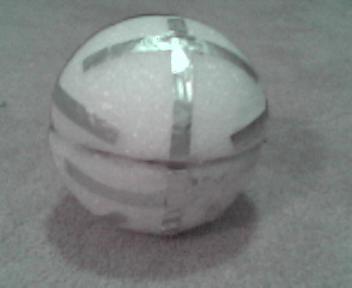
January 10, 2011
This project is a styrofoam ball, with powerful electronics components secured inside, along with a battery and accelerometers. The net result is when the acceleration of the ball changes (such as when catching, throwing, or shaking it) the holder of the ball will experience a slight electric shock. The idea arose purely out of curiosity, and to play pranks on others (hey, would you mind catching that?). As for the curiosity part, what really inspired me was an experiment with a large transformer - after connecting a regular harmless AAA battery to a 120/12V transformer (it better be unplugged boys and girls) and then disconnecting it, I noticed that an appreciable spark was generated, probably around 5000V to ionize air like that. At that point I had no idea why (see http://www.electronicsandyou.com/electronics-basics/inductors.html and http://pages.uoregon.edu/dparks/206/inductors/ if you're up for it), but I reasoned that the secondary windings must have an even higher-voltage spike, but the current is too low to ionize air in the same way. As it turns out, the spike on the secondary windings after connecting and removing a battery on the primary, is not visible but can be felt - thus a small and harmless shock. It actually feels different with different transformers and voltages, and it is most comparable to a static shock (touching side of car) except more localized.
Note: this experiment uses a AAA battery, which limits the amount of current put out. This was a purposeful decision. Doing this with more powerful batteries, even at the same voltage rating, will quickly make the shock quite unpleasant and possibly dangerous.
If you haven't tried the experiment with generating sparks from a AAA battery, you should! It is a way to learn a lot about electronic principles. (Note: even though the AA battery is small, this experiment is not for kids. You, the experimenter, need to understand what you are doing) Just get a big heavy transformer (the light ones are digitally controlled and not nearly as fun), good ones generally can be found in integrated audio equipment, such as alarm clocks and boombox-type radios. Make sure everything is unplugged and the device is to be discarded, then open up the device and the transformer will be a noticeable, probably heavy, metal-enclosed cube or rectangle shape, with two pairs of wires connected to it. A sure way to find it is to trace the path the wire used to plug in the device takes inside the device frame, because it will in 99% of cases go directly to the transformer. The mains wire contains two separate conductors, and there should be two other wires coming out of the transformer. Remove the transformer, strip the ends of the wires, and try connecting some regular batteries.
So what to make of the spark? This obviously can be used in a device for fun or pranks, but it requires connecting / disconnecting the battery. Coincidentally, a physical accelerometer (that is, one with moving parts) will move when a force is applied. If it is designed so that it connects the battery when accelerated, and disconnects it when it's not, it will effectively do the on/off switching automatically, and conveniently will not waste energy if left alone. The design I had in mind was a metal spring (such as one from a ballpoint pen) attached by one end to a stationary base, while the other end is inside a metallic cylinder and barely touching the sides. Whenever acceleration is applied to this device, the spring would touch the internal surface of the cylinder and conduct (connect battery). Once acceleration is removed (or reversed), the spring wants to return to its original state, which causes the circuit to break and the battery to disconnect, and this is what delivers the shock. You can see the accelerometers in the image below:

In between all the cardboard pieces, in the middle of the sphere, you can see the cutout and inside the two accelerometers. They contain a rigid base (bent coat hanger) and the cylinder is a drinking straw, covered with foil on the inside (now that was a challenge). The wires connect the sensors to the metal plates, which carry electricity between the two halves of the ball. In the top left corner, there are two holes labeled + and -, this is where the metal plates from the top half are inserted, providing a connection to the battery. This circuit is opened/closed by the accelerometers. A transformer in the second half then creates high voltage, which is transported back to the above hemisphere via the two metal plates in the bottom right corner.
As I mentioned, this works based on the principle of inductance, so when a person catches the ball, the spring in one of the accelerometers completes a circuit and charges the primary coil in the transformer. Eventually, the spring returns to its original position and breaks the circuit, thus causing the magnetic field in the transformer to break down suddenly, which creates the high potential which causes the shock. The outside surface is covered by two patterned sets of foil, one positive and the other negative. This is visible below, in the complete sphere:
